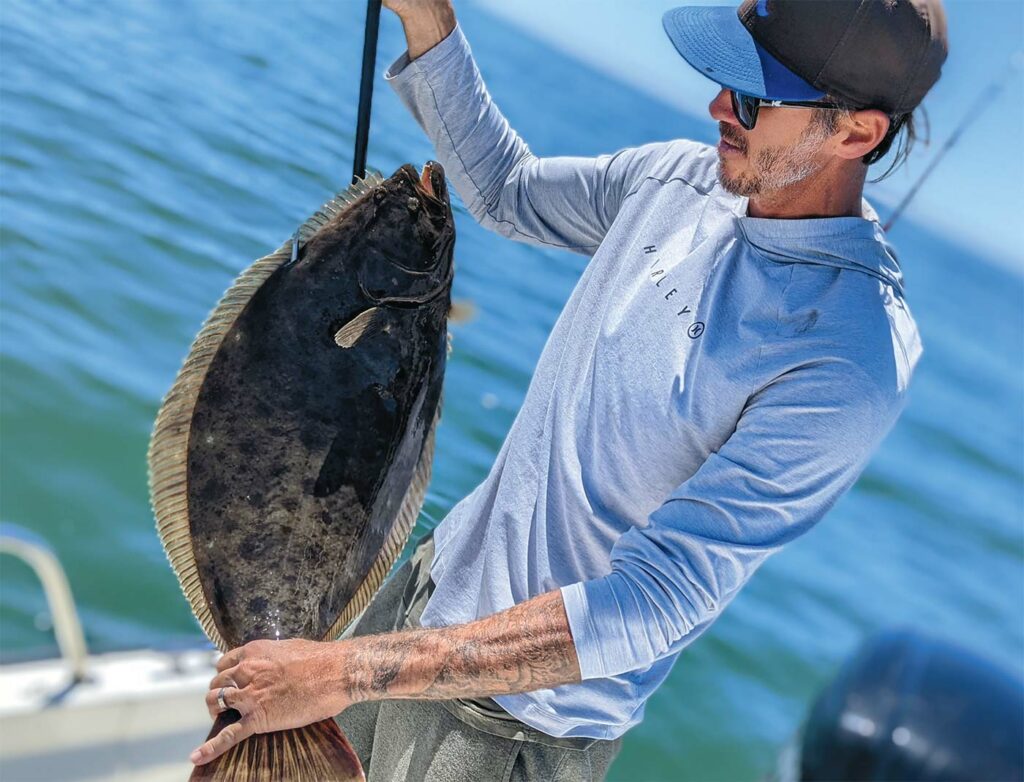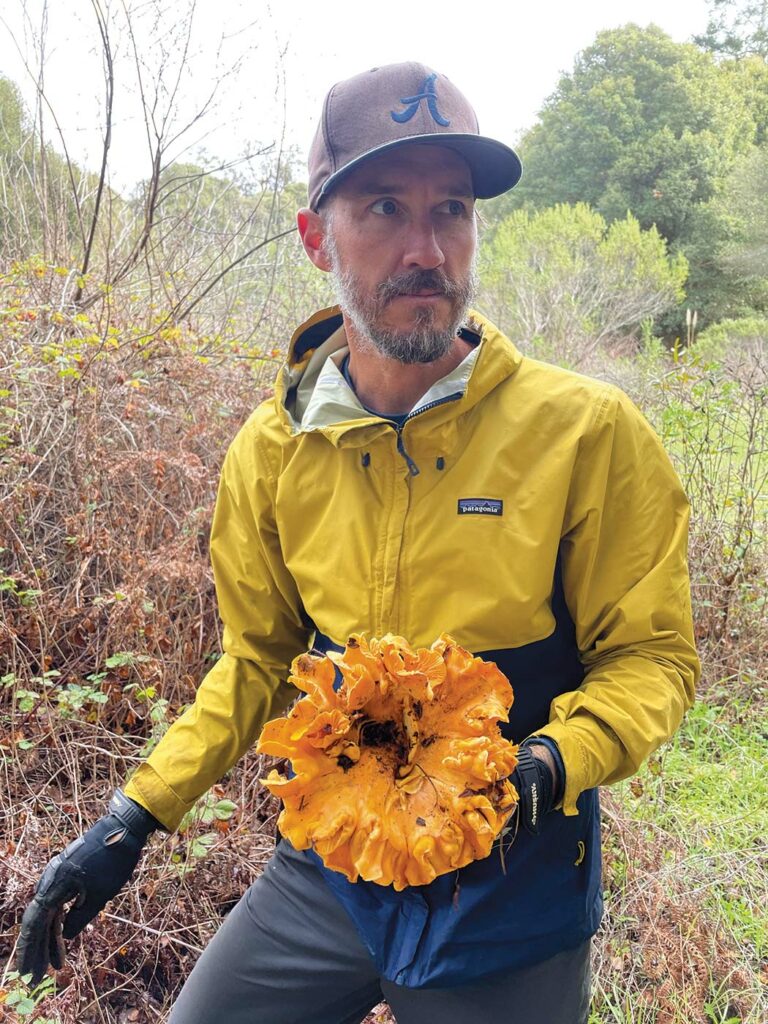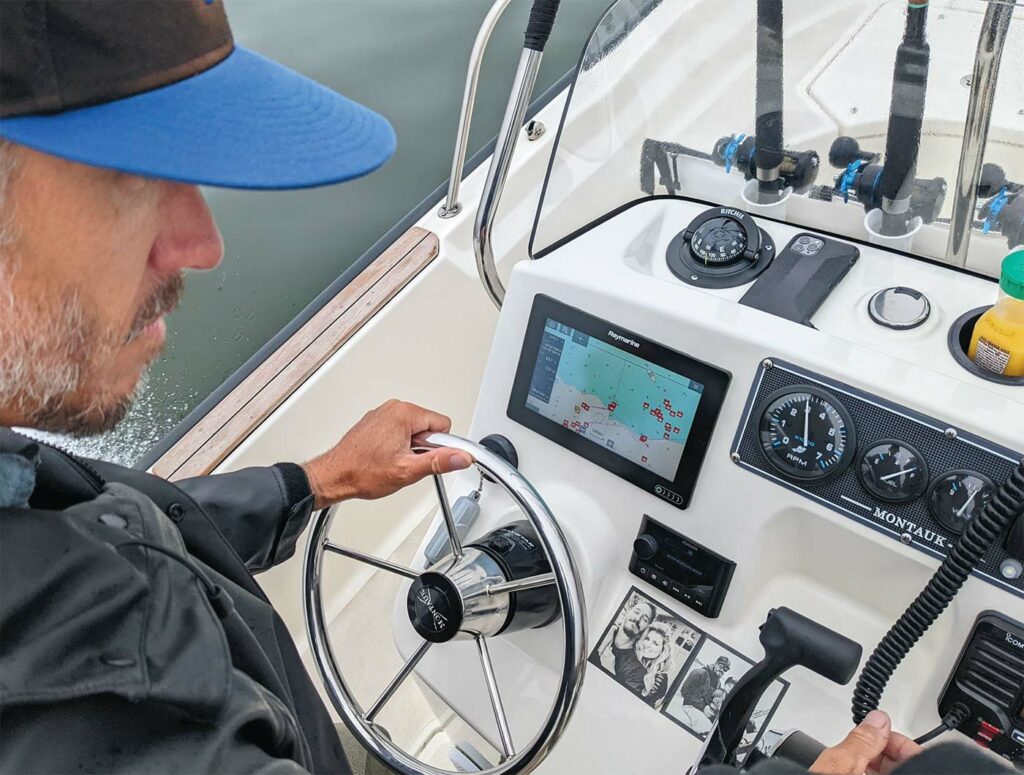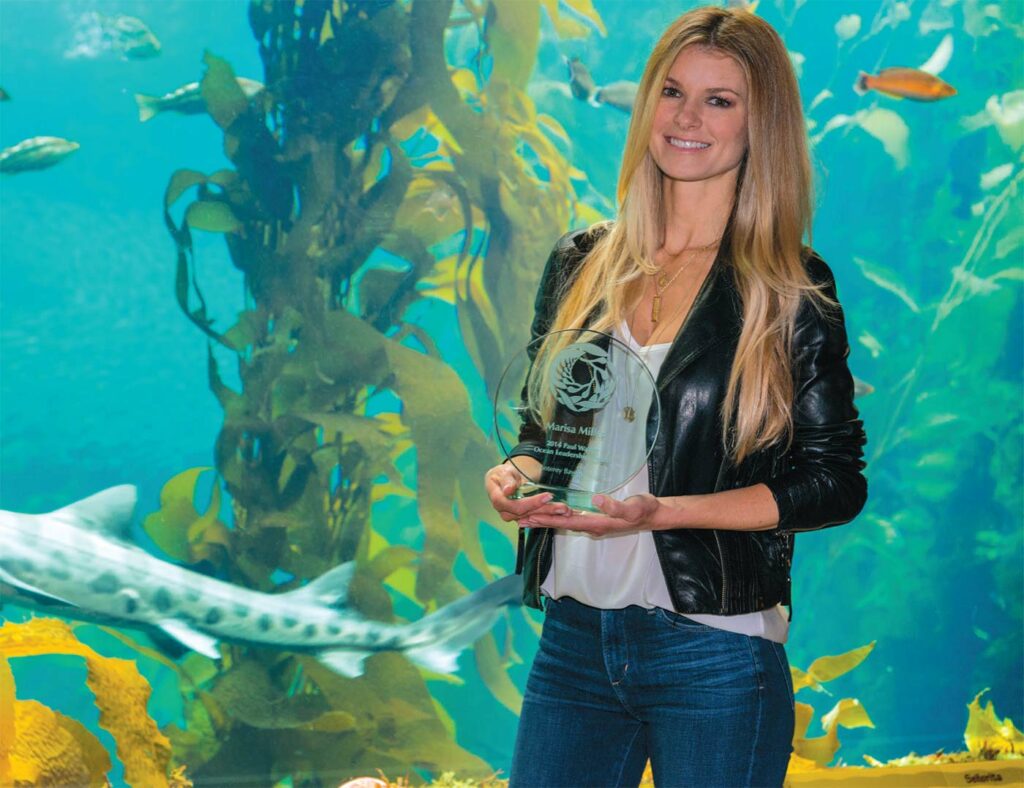
Former music mogul finds contentment fishing and foraging for Santa Cruz restaurants
PHOTOGRAPHY BY MARK C. ANDERSON
This tale starts with a taco.
A perpetual search for the area’s top fish tacos led me to Mijo’s Taqueria in Capitola for its best-selling Baja-style take with light and crispy tempura batter and lemon-cilantro aioli.
It’s a bangin’ dish done whenever possible with hyper-fresh halibut. Chef-owner-operator Anthony Guajardo reports he gets it directly from Gracie Fish, a one-man upstart operation run by a neophyte Aptos fisherman named Griffin Guess. Guajardo digs how Guess seeks out chefs personally, and delivers directly from the dock.
Guess loves Guarjardo’s priorities: “Anthony cares about where it comes from, when it comes—as fresh as possible—and with standards in place around how it was caught.”
Within a few weeks of some A-plus Mijo’s tacos, I headed down to Santa Cruz Harbor to learn more.
I soon discovered Guess nearly bled out at sea before he started Gracie, and before that dance with death spent a musical chapter of his life in Hollywood, collaborating with the likes of Metallica and 50 Cent.
“We don’t want to get in the way of what he brings us,” Sherman says. “The fish is so good and so fresh, you don’t want to hide that.”


LEARNING THE ROPES
There’s no great place to have a razor-sharp hook go deep into your finger.
Still, floating on a stand-up paddleboard a mile from the Capitola shore—holding a reel and cradling a crate of freshly caught fish—wouldn’t be near the top of the list.
But there Guess was, on the painful end of a sudden accident while removing the hook from the mouth of a halibut that slipped out of his grasp, flounder-whipped a moonwalk across the board and nose-dove deep, cranking barb into bone.
Bleeding and lightheaded, thinking about sharks’ sense for blood, realizing that hook isn’t going anywhere—no matter if he clips it or works it endlessly back and forth with the pliers in his free hand—Guess started the slow one-armed paddle through wind and chop toward land.
The craziest thing about that moment might not be the amount of bloodletting or how far he was from the beach, but how distant he was from his past life.
Spoiler alert: Guess survived the bloody SUP incident, even if the first wave of nurses at Dominican Hospital’s emergency room couldn’t get the hook out either. (A more muscular nurse eventually loosened it, and Guess finished the yank, now joking he spent $780 to remove the hook himself.)
In the following months he steadily evolved his craft and equipment.
He started tracking currents and water clarity and the way drifts dangle squid on his lines with maximum attraction. He traded stories with veteran fishermen. He studied how they rigged their rods.
“You realize that you could have a day where you catch a lot of fish, then go back to the same place, with the same system, and not catch nearly as many,” he says. “It made me curious about the places where nature provides mystery.”
Ed Burrell, who’s run Capitola Boat and Bait for decades, observes something special in the newbie.
“A lot of it is intuition,” he says. “And he gets along with everybody, so there’s a lot of shared knowledge. And he puts the time in.”
When Guess and I trundle out on our fishing mission, he talks trial and error around weight and bait, leads and lures and—yes—the benefits of trading a paddleboard for a small but well-equipped center-console Boston Whaler.
“Life is easier when you don’t have to worry about a shark coming to get you,” he says.
The weather goddesses grant us mellow conditions and mesmerizing skies. Poseidon is stingier.
After hours pass, we are almost out of time, and have pulled in only rockfish and a slippery young octopus, which were thrown back to sea, and a gorgeous vermilion lingcod, which was thrown in the ice chest.
Guess adjusts course, throttling toward backup spots he has geo-marked on his sonar GPS. He drops in multiple lines and suddenly hooks two hulking halibut in succession. With the rods, he’s patient and fluid, pulling and spooling, tugging then wheeling in the reel again.
“More ballet than turn and burn,” he says.
Additional fluidity follows: He scoops the huge fish out of the water with his gaff, lays it on the deck and in an instant removes the gills so the creature dies quickly, no clubbing required.
SELLING WITH SOUL
When I ask him who might be serving his halibut on that day, he runs down a curated list including Bittersweet Bistro in Aptos and East End Gastropub in Capitola.
One among them catches my appetite: Jack O’Neill Restaurant, where executive chef Gus Trejo has long made a habit of sourcing from the very best small farms and local foragers he can find, and lists them on each seasonal menu.
A while back Guess approached Trejo with descriptions of how (with pole and mindful handling) and where (on waters visible from the restaurant) he fishes. Trejo immediately agreed to buy whatever Guess brought in.
Today Guess helps train staff on the backstory of what’s on the plate, and Trejo describes an “old-school bond between fisherman and cook.”
“He gets the fish, brings it in—done,” Trejo says. “No brokers, no transferring fish in trucks.”
Reverence for the product is built into the bond.
“He treats the fish with the utmost respect,” Trejo says. “You can see it: no bruising or even scales out of place.”
What Trejo does with it demands drool, which happened by way of what I tried that same day: 1) a golden heirloom watermelon, ogo seaweed “leche de tigre” halibut ceviche, and 2) a seasonal “Gracie Pacific catch,” on this day, a tender and golden-crusted halibut fillet, brightened by a braised fennel and turmeric treatment sealed with a garlic chimichurri crunch.
“For Guess it’s not a business or a job; it’s a craft. I don’t know how to describe it— it’s a beautiful thing, and I transfer that to my kitchen,” Trejo says. ”We’re not a cult, but we are putting something into [guests’] bodies. Everybody that normally does that is a doctor. I tell my team, ‘We need to take care of this and use every ounce of this and make sure it’s used properly.’”
That includes keeping the freshness out front.
As with Trejo, that’s the priority for celebrated Trestles exec chef Nick Sherman, who was also approached by Guess. Sherman likes to incorporate the day’s catch into things like ponzu-splashed sashimi halibut tostadas with avocado mousse. “We don’t want to get in the way of what he brings us,” Sherman says. “The fish is so good and so fresh, you don’t want to hide that.”


MISSION IMPASSIONED
Deep in a secret gorge of bristling blackberry bushes, legacy oaks, Douglas fir, coastal pines and fanning ferns, Guess crouches to the duff. He brushes away the soft soil from a chanterelle so golden it almost glows. He lifts it softly with his middle and index fingers, then rotates it counterclockwise until it’s loose enough to lift without a tear.
He’s in another wild and local place, again treating his harvest gently, again several dimensions distant from his former existence.
And like the sea—hooked finger or not—the forest has its dangers: Inattention to a slippery log, blackberry tripwires, a patch of poison oak branches, unsteady embankment or rain-loosened tree means it’s back to Dominican, or worse.
“It can be totally vicious,” he says. “And after these rains you have to watch out for landslide log rides.”
He started foraging after hiking his home acreage with his boys and coming across two picture-perfect porcini. Now he drives rural roads looking for specific sorts of water drainage and heads off into the scrub brush in search of mushrooms he can hand sell to chefs.
As with fishing, Guess is learning as he goes, and getting more comfortable with a quickness.
“I’d like to think I have an intuition for it that I’m trying to cultivate,” he says. “I used to mark maps. Now I can read tree species and know where I am, and really start seeing everything and targeting edibles.”
Chefs like Trejo make those edibles incredible—think chanterelle-burrata flatbreads, Indigenous corn-chanterelle polentas, chanterelle-duck confit—though Guess puts it a different way.
“It’s insane,” he says. “I’ve never had anything like it.”

CONSCIOUS SHIFT
Something was nagging at me, and it had nothing to do with seafood or mushrooms.
Early into our fishing voyage, Guess shows me how his radar reports movement, depth and density of what’s moving below, adding, “Halibut move around in packs, like wolves.”
That’s when I recognize the woman in the photo affixed to the dashboard above his radar read-out. Only I can’t place her.
As we motor back to dock, talk turns to his wife’s work with the Monterey Bay Aquarium, and it clicks: Years ago I interviewed her for her recognition as an aquarium Ocean Advocate. Millions know Marisa Miller better as a supermodel and actress; she’s also an avid horseback rider, surfer and Santa Cruz native.
Guess met her on a plane flying to Miami to meet Kanye West, who had him in a “right-hand man” role helping produce records, concerts and marketing campaigns. Later West would give a speech at their wedding, though they’ve since gone different directions, personally, professionally and, well, philosophically.
In that same past life, Guess also won a boatload of shiny awards. He directed tours for Eminem and led promotions for Harley-Davidson. He consulted Steve Jobs on then-infant iTunes. He was also a label owner, producer and marketing chief for the likes of Weezer, Metallica and Jay-Z.
“A lot happened in 20 years,” he says. “I earned my freedom. When we had kids, we did not focus on our careers, and now it’s every waking moment with the boys. I’m grateful for that. Homeschool is tribal, and has its challenges, but I’m never turning back.”
His background presents a twist I didn’t see coming, and one Guess doesn’t advertise. The main point is he’s more content navigating fish lines than velvet ropes, coaching his boys’ baseball team than seeing their births surface on E! News, spending time on the water and in the woods rather than on the stage and in the studio.
Most of his Grammy Awards sit on the floor of his garage. When we meet this winter to talk mushroom foraging, he shakes his head at the shift.
“Did I ever envision this? Do I feel more alive?” he thinks out loud. “Maybe the joke was on me, thinking those other things were more important.
“Now, standing in the middle of the woods, I don’t feel any more important than a bird in a tree. It takes a minute to let your guard down and just exist in the simplest form—to just exist. Possessions don’t matter, money is a tool to support your kids. Teslas are cool, but so is the planet.”
About the author
Mark C. Anderson, Edible Monterey Bay's managing editor, appears on "Friday Found Treasures" via KRML 94.7 every week, a little after 12pm noon. Reach him via mark@ediblemontereybay.com.
- Mark C. Andersonhttps://www.ediblemontereybay.com/author/markcanderson/
- Mark C. Andersonhttps://www.ediblemontereybay.com/author/markcanderson/
- Mark C. Andersonhttps://www.ediblemontereybay.com/author/markcanderson/
- Mark C. Andersonhttps://www.ediblemontereybay.com/author/markcanderson/



